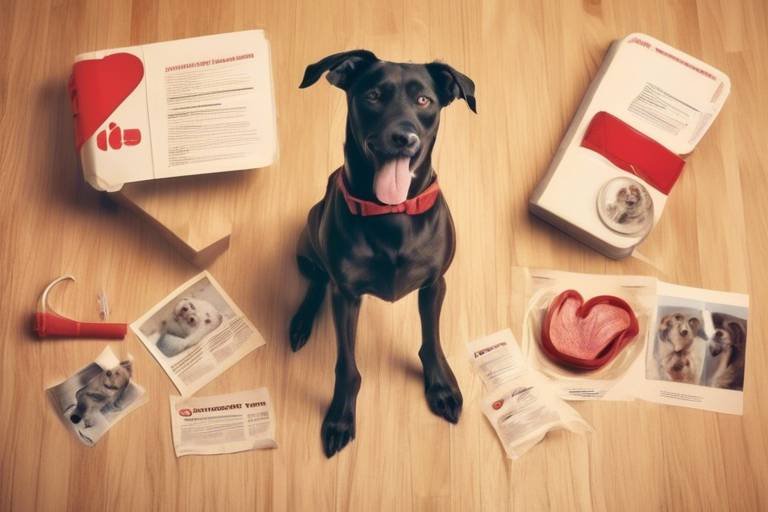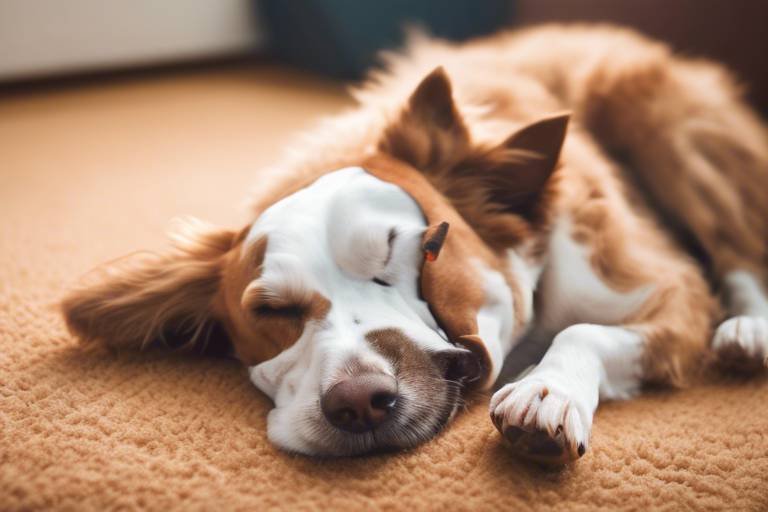The Role of Exercise in Preventing Obesity in Pets
Obesity in pets is not just a cosmetic issue; it's a serious health crisis that can lead to a myriad of problems. Just like humans, our furry friends can struggle with weight management, and the consequences can be dire. Regular exercise plays a pivotal role in keeping our pets fit and healthy, and it’s something every pet owner should prioritize. Imagine your pet as a well-oiled machine; without the right fuel and maintenance—like exercise—they can start to rust and malfunction. In this article, we will explore the significance of regular physical activity, the types of exercises that suit different pets, and how to establish a routine that keeps them happy and healthy.
Pet obesity is a growing concern that can lead to serious health issues. According to the Association for Pet Obesity Prevention, over 50% of dogs and cats in the United States are classified as overweight or obese. This alarming statistic highlights the urgent need for pet owners to take action. The causes of obesity are multifaceted, ranging from overfeeding and lack of exercise to genetics and underlying health conditions. The risks associated with being overweight include diabetes, joint problems, and cardiovascular diseases. Think of it this way: just as a car can’t run efficiently without proper maintenance, our pets can’t thrive without a balanced diet and regular exercise. Preventive measures are crucial, and understanding the importance of exercise is the first step.
Regular exercise is crucial for pets to maintain a healthy weight. It’s not just about shedding pounds; it’s about enhancing their overall well-being. Exercise offers a plethora of physical benefits, such as improved cardiovascular health, stronger muscles, and better digestion. But let’s not forget the mental benefits! Engaging in physical activities can reduce anxiety and boredom, leading to happier, more balanced pets. Just as a walk in the park can rejuvenate your spirit after a long day, the same goes for our pets. They thrive on interaction and stimulation, and exercise provides the perfect outlet for their energy. So, how do we ensure our pets get the exercise they need?
Different types of exercises cater to various pet needs. Dogs, for instance, often require more vigorous activities, while cats may enjoy shorter bursts of play. Here are some popular activities suitable for both dogs and cats:
- Walking and Running: A daily walk is a simple yet effective way to keep your dog fit. For cats, consider a harness and leash for safe outdoor exploration.
- Interactive Play: Engage your pet with toys that stimulate their natural hunting instincts. For dogs, fetch is a classic, while cats love feather wands.
- Agility Training: Setting up an obstacle course in your backyard can turn exercise into a fun game for both dogs and cats.
Outdoor activities provide pets with fresh air and socialization opportunities. Engaging in activities like hiking, playing fetch, or exploring parks not only enhances physical fitness but also offers mental stimulation. Picture your dog bounding through a field, tail wagging, or your cat prowling through the tall grass—these experiences are invaluable. They allow pets to interact with their environment and other animals, which can be incredibly enriching. Plus, it’s a fantastic way for owners to bond with their pets while enjoying nature!
Indoor exercises are essential for pets, especially during inclement weather. Keeping pets active indoors can be a challenge, but it’s certainly doable! Here are some creative ways to keep pets engaged:
- Interactive Toys: Puzzle toys can keep your pet mentally stimulated while they work for their treats.
- Obstacle Courses: Use furniture and household items to create a mini obstacle course for your pet to navigate.
- Games: Simple games like hide-and-seek can be entertaining for both pets and owners.
Creating a consistent exercise routine is vital for pet health. Just like humans thrive on routine, pets do too! Establishing a regular exercise schedule that accommodates both the pet's and owner's lifestyle is essential. Start small—aim for short walks or play sessions, gradually increasing the duration as your pet builds endurance. Consistency is key; try to incorporate exercise into your daily routine, making it a fun and expected part of your day. Think of it as a shared adventure!
Regularly monitoring your pet's weight is essential for preventing obesity. Keeping an eye on their weight can help you catch any changes early on. Weigh your pet regularly and maintain a log. If you notice a significant weight gain, it might be time to reassess their diet and exercise routine. Remember, a healthy pet is a happy pet!
Recognizing the signs of overweight pets can help owners take timely action. Common indicators include:
- Difficulty in feeling their ribs
- Excess fat around the waist
- Reduced energy levels
- Difficulty in breathing during exercise
If you notice these signs, it’s important to consult with a veterinarian to discuss a suitable weight management plan.
Consulting a veterinarian is crucial for a tailored weight management plan. A professional can provide guidance on the appropriate diet and exercise regimen for your pet. They can also help rule out any underlying health issues that may contribute to weight gain. Just as you would consult a doctor for your health, your pet deserves the same level of care. Remember, a proactive approach can lead to a longer, healthier life for your furry companion.
Q: How much exercise does my pet need?
A: The amount of exercise varies by breed and age. Generally, dogs need at least 30 minutes to two hours of exercise daily, while cats may require shorter play sessions throughout the day.
Q: What are the best exercises for older pets?
A: Low-impact activities like gentle walks and light play are ideal for older pets. Always consult your veterinarian for personalized recommendations.
Q: Can indoor pets get enough exercise?
A: Absolutely! Indoor pets can stay active through interactive toys, games, and structured playtime. Creativity is key!

Understanding Pet Obesity
Pet obesity is a growing concern that affects millions of animals worldwide. Just like humans, our furry friends can struggle with weight issues, leading to a myriad of health problems. In fact, studies show that approximately 50% of dogs and 40% of cats in the United States are classified as overweight or obese. This alarming trend is largely due to a combination of factors including poor diet, lack of exercise, and even genetics. As pet owners, it is our responsibility to ensure that our pets maintain a healthy weight to promote their overall well-being.
The causes of obesity in pets can be quite varied. A primary contributor is the overconsumption of calories. Many pet owners may not realize how many treats and table scraps they are giving their pets, which can quickly add up. Additionally, sedentary lifestyles, especially in urban environments where outdoor space is limited, can hinder regular physical activity. Moreover, certain breeds are predisposed to gaining weight, making it crucial for owners of these breeds to be particularly vigilant.
Obesity in pets is not just a cosmetic issue; it poses serious health risks. Overweight pets are at a much higher risk of developing conditions such as:
- Diabetes - Excess weight can lead to insulin resistance.
- Joint problems - Extra weight puts additional strain on joints, leading to arthritis.
- Heart disease - Obesity can affect cardiovascular health.
- Respiratory issues - Excess fat can impact breathing, especially in brachycephalic breeds.
- Shortened lifespan - Studies indicate that overweight pets may live shorter lives than their healthier counterparts.
Recognizing the risks associated with pet obesity is the first step towards prevention. As responsible pet owners, we should strive to educate ourselves about proper nutrition and the importance of regular exercise. By creating a balanced diet and incorporating physical activity into our pets' daily routines, we can significantly reduce the chances of our furry companions becoming overweight. Not only does this improve their health, but it also enhances their quality of life, making them happier and more active members of the family.
In summary, understanding pet obesity is crucial for every pet owner. By being aware of the causes, prevalence, and health risks, we can take proactive steps to ensure our pets lead healthy, fulfilling lives. After all, a healthy pet is a happy pet!

The Importance of Regular Exercise
When it comes to keeping our furry friends happy and healthy, regular exercise is a game-changer. Just like humans, pets need to move their bodies to stay fit and maintain a healthy weight. Imagine a dog cooped up inside all day; it’s like a kid being stuck in a classroom without recess! Not only does exercise help prevent obesity, but it also plays a crucial role in enhancing their overall well-being.
Engaging in physical activity offers a plethora of benefits for pets. For starters, it helps to burn off excess calories, which is essential for weight management. But the perks don’t stop there! Regular exercise also improves cardiovascular health, strengthens muscles, and boosts flexibility. Think of it as a natural way to keep their heart pumping and their joints limber. In addition, exercise can significantly reduce the risk of chronic diseases, such as diabetes and arthritis, which are common in overweight pets.
Moreover, exercise is not just about physical health; it’s a fantastic way to stimulate your pet’s mind. Pets, especially dogs, thrive on mental challenges and interactive play. Activities that require problem-solving or agility can keep their brains sharp and engaged. Just picture a dog navigating an obstacle course or a cat chasing after a laser pointer—these activities are not only fun but also mentally rewarding!
Another critical aspect of regular exercise is its impact on behavioral health. Pets that don’t get enough exercise may exhibit signs of boredom or anxiety, leading to destructive behaviors like chewing furniture or excessive barking. By incorporating exercise into their daily routine, you’re not just keeping them physically fit; you’re also promoting a balanced mood and a happier disposition. It’s like giving them a dose of happiness every day!
So, how much exercise does your pet need? The answer can vary based on their age, breed, and health condition. Generally, dogs require at least 30 minutes to 2 hours of exercise each day, while cats can benefit from shorter bursts of playtime throughout the day. As a responsible pet owner, it’s essential to tailor an exercise regimen that suits your pet’s individual needs.
In conclusion, regular exercise is vital for preventing obesity and ensuring a pet's overall health and happiness. It’s not just about losing weight; it’s about enriching their lives. By making exercise a fun and integral part of your pet’s daily routine, you’re investing in their long-term well-being. Remember, a happy pet is a healthy pet!
Types of Exercises for Pets
When it comes to keeping our furry friends fit and healthy, understanding the types of exercises suitable for them is crucial. Just like humans, pets have different energy levels and preferences, which means the exercise routine should be tailored to their specific needs. Whether you have a playful puppy or a laid-back cat, there are plenty of activities to keep them active and engaged. Let’s dive into some popular exercise options that can cater to various pet types.
For dogs, the classics like walking and running are fundamental. Daily walks not only provide physical exercise but also expose them to new sights and smells, which can be mentally stimulating. If your dog has a bit more energy to burn, consider incorporating jogging or cycling into your routine. These activities can be a great way for both of you to get your heart rates up while enjoying the great outdoors together.
But let’s not forget about the fun factor! Dogs love to play fetch, and this game is a fantastic way to combine exercise with playtime. Not only does it improve their physical fitness, but it also strengthens the bond between you and your pet. For those days when you can’t head outside, consider investing in some interactive toys. These can keep your dog entertained and active, even within the confines of your living room.
Now, let’s shift gears and talk about our feline friends. Cats may not require as much structured exercise as dogs, but they still need to stay active. Engaging them in interactive play is vital. You can use feather wands, laser pointers, or even simple strings to get them moving. Cats are natural hunters, so simulating a chase can be incredibly beneficial for their physical and mental health.
Additionally, consider creating an obstacle course in your home. This can involve climbing over furniture or jumping through hoops, which not only keeps them physically active but also sharpens their agility and coordination. Indoor exercise is especially important during harsh weather when outdoor activities are limited.
In summary, providing a variety of exercise options for your pets is essential for their overall well-being. By mixing outdoor adventures with indoor activities, you can ensure that your pets remain happy, healthy, and engaged. Remember, the key is to find what your pet enjoys the most and keep it fun!
- How much exercise does my pet need? - It varies by breed and age, but generally, dogs should get at least 30 minutes of exercise daily, while cats can benefit from several short play sessions throughout the day.
- What are some signs my pet is not getting enough exercise? - Look for signs like weight gain, lethargy, and destructive behavior. If your pet seems restless or bored, it might be time to amp up their activity levels.
- Can I exercise my pet indoors? - Absolutely! There are plenty of ways to keep your pet active indoors, such as using toys, creating obstacle courses, or engaging in interactive games.
Outdoor Activities
Outdoor activities are not just a fun way for pets to burn off energy; they are also vital for their overall health and well-being. Think of it this way: just like we humans feel rejuvenated after a brisk walk in the park, our furry companions thrive in the great outdoors. Engaging in outdoor activities allows pets to explore their environment, socialize with other animals, and enjoy the fresh air, all of which contribute to a healthier lifestyle.
One of the most popular outdoor activities is hiking. Taking your dog on a hiking adventure not only provides them with a great workout but also stimulates their senses. The sights, sounds, and smells of nature can be incredibly enriching for pets, making the experience both physically and mentally rewarding. Just imagine your pup bounding through the woods, tail wagging with excitement as they discover new trails and scents!
Another fantastic outdoor activity is playing fetch. This classic game is a great way to get your pet moving while also strengthening the bond between you and your furry friend. You can use a variety of toys, such as balls or frisbees, to keep things interesting. Not only does fetch help improve your pet's cardiovascular health, but it also enhances their agility and coordination. Plus, the joy of retrieving that toy brings a sparkle to their eyes that is truly priceless.
Exploring local parks is another excellent option. Parks often provide ample space for pets to run freely, interact with other dogs, and enjoy the sights and sounds of nature. Many parks even have designated areas for dogs, allowing them to play off-leash in a safe environment. This socialization is crucial for pets, as it helps them develop good behavior and reduces anxiety in new situations.
To make the most of outdoor activities, it's essential to keep your pet's safety in mind. Always bring plenty of water, especially on warm days, to keep your pet hydrated. Additionally, consider using a leash in unfamiliar areas to prevent them from wandering off or getting into trouble. Remember, the goal is to create a fun and safe experience that encourages your pet to stay active!
In conclusion, outdoor activities are not just about exercise; they are a way to enrich your pet's life and strengthen your bond. So, lace up those sneakers, grab a leash, and head outside with your furry friend. The benefits of outdoor play will not only help prevent obesity but also create memories that you both will cherish for years to come.
- How much exercise does my pet need? The amount of exercise varies by breed and age. Generally, dogs need at least 30 minutes to 2 hours of activity daily, while cats benefit from 15-30 minutes of playtime.
- Can indoor activities replace outdoor exercise? While indoor activities can help, they should complement outdoor exercise rather than replace it. Both are essential for a balanced routine.
- What are some signs my pet is getting enough exercise? Signs include a healthy weight, increased energy levels, and a happy demeanor. If your pet seems restless or overweight, it may need more exercise.
- Is it safe to take my pet hiking? Yes, but ensure your pet is physically fit for the hike and always bring water and a first-aid kit. Check the trail for pet-friendly regulations.
Indoor Exercises
When the weather outside is frightful, it’s easy to let your furry friends become couch potatoes. However, keeping your pets active indoors is not only possible but also essential for their health and happiness! Just like us, pets need regular exercise to maintain a healthy weight and prevent obesity. So, how can you keep your pets engaged and active when the rain is pouring or the snow is falling? Let’s explore some creative indoor exercises that will keep their tails wagging and their spirits high.
One of the simplest ways to get your pet moving indoors is through interactive play. Engage your dog or cat with their favorite toys. For dogs, consider using a sturdy tug toy or a squeaky ball. Cats, on the other hand, love feather wands or laser pointers. These activities not only provide physical exercise but also stimulate your pet's mind. Just imagine your cat chasing that elusive red dot or your dog performing tricks for their favorite toy—it’s a win-win!
Another fantastic option is to set up an obstacle course in your living room. You can use everyday household items like chairs, cushions, and boxes to create a fun and challenging course. Encourage your pet to jump over, crawl under, and weave through the obstacles. This not only helps them burn off energy but also enhances their agility and coordination. Plus, it’s a great way for you to bond with your pet while having fun together!
For those pets that love a good chase, consider playing a game of hide and seek. This classic game can be adapted for pets by hiding treats or their favorite toys around the house. Allow your pet to use their nose and instincts to find them. This not only encourages physical activity but also stimulates their natural hunting instincts. Just be prepared for some excited barks or meows when they discover their hidden treasures!
If your pet enjoys more structured activities, you might want to look into training sessions. Teaching your pet new tricks or reinforcing existing commands is an excellent way to keep their minds active while also providing physical exercise. Whether it’s a simple “sit” or a more complex trick like “roll over,” training sessions can be a fun and rewarding way to bond with your pet. Plus, it’s a great opportunity to reward them with treats, which can help motivate them to participate.
Lastly, consider incorporating treadmill workouts into your pet’s routine, especially for dogs. Yes, you heard that right! Dogs can be trained to walk on a treadmill, which is a fantastic way to get them moving when outdoor options are limited. Start slowly, allowing your dog to get used to the machine, and gradually increase the pace as they become more comfortable. Always supervise your pet during treadmill workouts to ensure their safety.
In summary, indoor exercises can be both fun and beneficial for your pets. By incorporating a variety of activities such as interactive play, obstacle courses, hide and seek, training sessions, and even treadmill workouts, you can keep your pets active and engaged, regardless of the weather. Remember, a little creativity goes a long way in ensuring your furry friends stay fit and healthy!
- How much indoor exercise does my pet need? It depends on the breed and age of your pet, but generally, aim for at least 30 minutes of active play each day.
- Can indoor exercises replace outdoor walks? While indoor exercises are beneficial, they should complement outdoor activities whenever possible for fresh air and socialization.
- What if my pet doesn’t seem interested in indoor activities? Try different toys or activities until you find something that excites them. Sometimes, a little experimentation is needed!
Establishing an Exercise Routine
Establishing a consistent exercise routine for your pet is like creating a personalized fitness plan for yourself—it requires dedication, understanding, and a bit of creativity. Just as we thrive on structure and variety in our workouts, our furry friends also benefit from a well-thought-out exercise schedule that fits their unique needs and lifestyles. So, how do you get started? First, it's essential to assess your pet's current activity level and health status. If your pet is new to exercise or has been mostly sedentary, you’ll want to start slow and gradually increase the intensity and duration of the activities.
One effective way to establish a routine is to set specific times for exercise each day. Just like you might schedule a gym session, consider scheduling walks or playtime into your daily agenda. For example, you could take your dog for a morning walk before work or set aside time in the evening for a fun game of fetch. Not only does this create a sense of anticipation for your pet, but it also helps you stay accountable. Remember, consistency is key! If you can stick to a routine, your pet will quickly adapt and look forward to their daily activities.
In addition to scheduling, it’s essential to incorporate a variety of exercises to keep things interesting. Think of it as cross-training for pets. You can mix up outdoor activities like hiking or running with indoor play sessions using toys or agility equipment. This variety not only keeps your pet engaged but also ensures they are using different muscle groups, which promotes overall fitness. For instance, a typical week could look something like this:
| Day | Activity | Duration |
|---|---|---|
| Monday | Morning Walk | 30 minutes |
| Tuesday | Indoor Playtime | 20 minutes |
| Wednesday | Agility Training | 30 minutes |
| Thursday | Evening Fetch | 30 minutes |
| Friday | Hiking | 1 hour |
| Saturday | Playdate with Other Pets | 1 hour |
| Sunday | Rest Day | - |
Finally, don’t forget to monitor your pet’s progress and adjust the routine as needed. Just like humans, pets can experience changes in energy levels, health, and preferences. Keep an eye on how your pet responds to different activities, and be flexible enough to change things up if something isn’t working. If your pet seems bored or tired, it might be time to introduce new games or try different locations for your exercise sessions. After all, the goal is to make exercise a fun and rewarding part of their daily life!
- How much exercise does my pet need? The amount of exercise varies by species, breed, and age. Generally, dogs require at least 30 minutes to 2 hours of exercise daily, while cats may need 15-30 minutes of active play.
- What if my pet doesn't enjoy exercise? It’s essential to find activities that your pet enjoys. Experiment with different games and types of exercise until you find something that excites them.
- Can I exercise my pet indoors? Absolutely! Indoor exercises like fetch, tug-of-war, and agility courses can be great alternatives, especially during bad weather.
- Should I consult a vet before starting an exercise routine? Yes, consulting a veterinarian is a good idea, especially if your pet has health concerns or is overweight.

Monitoring Your Pet's Weight
Regularly is essential for preventing obesity and ensuring a long, healthy life for your furry friend. Just like humans, pets can struggle with weight issues, and it's often up to us as responsible pet owners to keep an eye on their health. But how do you know if your pet is overweight? What signs should you look for, and how can you effectively track their weight? Let's dive into the importance of monitoring your pet's weight and the best practices to do so.
First and foremost, it's crucial to understand that weight management is not just about aesthetics; it's about your pet's overall health. Obesity in pets can lead to serious health complications such as diabetes, heart disease, and joint problems. Therefore, keeping track of your pet's weight should be a regular part of your pet care routine. You might wonder, "How often should I weigh my pet?" A good rule of thumb is to check their weight every month. This frequency allows you to catch any weight gain early and make necessary adjustments to their diet or exercise routine.
To effectively monitor your pet's weight, you can use a combination of methods:
- Weighing Scales: Invest in a good quality pet scale. You can either buy one or visit your veterinarian for regular weigh-ins.
- Body Condition Score (BCS): This scoring system helps assess whether your pet is at a healthy weight. A BCS chart typically ranges from 1 to 9, with 4 to 5 being ideal.
- Visual Checks: Regularly observe your pet's body shape. You should be able to see a waistline when looking from above, and you should feel their ribs without excessive pressure.
Furthermore, it's essential to keep a weight log. This log can be a simple table where you record your pet’s weight over time, which will help you identify trends and make informed decisions. Here's a sample of what that might look like:
| Date | Weight (lbs) | Notes |
|---|---|---|
| 01/01/2023 | 25 | Initial weight |
| 02/01/2023 | 24.5 | Started new exercise routine |
| 03/01/2023 | 24 | Weight stable |
Recognizing the signs of overweight pets is equally vital. If your pet is having difficulty jumping onto furniture, seems lethargic, or is less active than usual, these could be indicators that they are carrying extra weight. Furthermore, behavioral changes like increased begging or food stealing can also signal weight issues. If you notice any of these signs, it’s time to reassess their diet and exercise plan.
Lastly, consulting a veterinarian is crucial for a tailored weight management plan. Your vet can provide professional guidance tailored to your pet's specific needs, including dietary recommendations and suitable exercise routines. This partnership is invaluable as it ensures that your pet remains healthy and happy, avoiding the pitfalls of obesity.
- How often should I weigh my pet? It's recommended to weigh your pet monthly to monitor any significant changes.
- What is the Body Condition Score? The Body Condition Score is a system used to assess whether a pet is underweight, ideal weight, or overweight based on their physical appearance.
- When should I consult a veterinarian about my pet's weight? If you notice any significant weight gain or loss, or if your pet shows signs of lethargy or discomfort, it’s best to consult your veterinarian.
Signs of Overweight Pets
As pet owners, it's our responsibility to ensure our furry friends are healthy and happy. However, many of us might not realize that our pets are carrying around extra weight until it becomes a significant issue. Recognizing the is crucial for taking timely action to improve their health. So, what should you look for? Well, let’s dive into some key indicators that might suggest your pet is tipping the scales.
One of the most noticeable signs is the visual appearance of your pet. If you find it difficult to see their waistline or if they have a rounded belly, these could be red flags. Ideally, when you look at your pet from above, you should see a slight indentation at the waist. If the waist is barely visible or absent, it might be time to reassess their diet and exercise routine.
Another important aspect to consider is your pet's activity level. Has your usually playful pup suddenly turned into a couch potato? If your pet seems lethargic and is less willing to engage in play or walks, it could be a sign that they're carrying excess weight. Similarly, if your pet gets tired quickly during walks or playtime, this could indicate that their weight is affecting their stamina.
Additionally, pay attention to your pet's breathing patterns. Overweight pets often have labored breathing, especially after minimal exertion. If you notice your pet panting excessively or struggling to catch their breath after a short play session, this could be a serious concern. It's essential to monitor these signs closely, as they can lead to more severe health issues.
Behavioral changes can also provide clues. If your pet becomes more irritable or less social, it might be due to discomfort caused by excess weight. They might avoid activities they once enjoyed, leading to a vicious cycle of inactivity and further weight gain. Keep an eye out for these behavioral shifts as they can be subtle but telling.
Finally, regular vet check-ups are also vital in monitoring your pet's weight. Your veterinarian can provide a more accurate assessment of your pet's weight relative to their breed and size. They can also help identify any underlying health issues that might be contributing to weight gain.
In summary, being vigilant about these signs can help you catch potential weight issues early. Remember, a healthy pet is a happy pet, and taking proactive steps can lead to a longer, more fulfilling life for your furry companion.
- How can I tell if my pet is overweight? Look for visual signs like a lack of a defined waist, lethargy, and changes in breathing patterns.
- What should I do if I think my pet is overweight? Consult your veterinarian for a tailored weight management plan that includes diet and exercise.
- Are certain breeds more prone to obesity? Yes, some breeds are genetically predisposed to gain weight, making it essential to monitor their diet and exercise closely.
- Can I help my pet lose weight at home? Yes, you can implement a structured exercise routine and adjust their diet, but professional guidance is recommended.
Consulting a Veterinarian
When it comes to managing your pet's weight, consulting a veterinarian is not just a good idea; it's a critical step in ensuring your furry friend lives a long and healthy life. Your veterinarian is like a personal trainer and nutritionist rolled into one, equipped with the knowledge and tools necessary to help you navigate the often confusing world of pet health. They can offer personalized advice tailored specifically to your pet's breed, age, and current health status, making sure that you’re not just guessing when it comes to exercise and diet.
One of the most important aspects of this consultation is the comprehensive health assessment. Your vet will likely conduct a thorough examination, checking for any underlying health issues that could contribute to weight gain or hinder your pet's ability to exercise. Conditions like hypothyroidism or arthritis can significantly affect your pet's weight and activity levels, and addressing these issues can make a world of difference.
Additionally, your veterinarian can help you establish a tailored weight management plan. This plan may include dietary recommendations, portion sizes, and specific exercise routines that are safe and effective for your pet. For example, if your dog is a senior, your vet might suggest gentler activities like swimming or short, leisurely walks rather than high-impact exercises. On the other hand, an energetic young cat might benefit from interactive play sessions that stimulate both their body and mind.
Moreover, tracking progress is essential in any weight management plan. Your veterinarian can help you set realistic goals and provide you with tools to monitor your pet’s weight over time. Keeping a record of weight changes can help identify patterns and make adjustments to the plan as needed. This is particularly important because weight loss in pets should be gradual; rapid weight loss can lead to health complications, including liver disease.
Don't hesitate to ask questions during your visit. Inquire about the best types of food for your pet, how to read pet food labels, and what signs to look for that might indicate your pet is not losing weight as expected. Your vet is there to help, and understanding the nuances of pet nutrition and exercise can empower you to make informed decisions.
In summary, consulting a veterinarian is a fundamental aspect of preventing and managing obesity in pets. With their expertise, you can create a comprehensive plan that not only helps your pet shed those extra pounds but also enhances their overall well-being. Remember, your vet is your partner in this journey, and together, you can help your furry companion lead a healthier, happier life.
- How often should I take my pet to the veterinarian for weight management? It's recommended to have a check-up every 6 months, but your vet may suggest more frequent visits based on your pet's specific needs.
- Can I create a weight loss plan for my pet without consulting a vet? While you can make general changes, a vet's guidance ensures that the plan is safe and effective for your pet's unique health profile.
- What are some signs that my pet is overweight? Look for difficulty in breathing, reluctance to exercise, and visible fat deposits around the ribs and abdomen.
- How long will it take for my pet to lose weight? Weight loss varies by individual, but a safe rate is typically 1-2% of body weight per week.
Frequently Asked Questions
- What causes obesity in pets?
Obesity in pets can be caused by a variety of factors, including overfeeding, lack of exercise, and certain medical conditions. Just like humans, pets can gain weight if they consume more calories than they burn. It's important to monitor their diet and activity levels to prevent obesity.
- How much exercise does my pet need?
The amount of exercise your pet needs can vary based on their age, breed, and health status. Generally, dogs require at least 30 minutes to 2 hours of exercise daily, while cats may benefit from 15 to 30 minutes of active playtime. Tailoring the exercise routine to fit your pet's specific needs is essential for their well-being.
- What are some fun exercises for pets?
There are plenty of fun exercises to keep your pets engaged! For dogs, activities like fetch, tug-of-war, and agility training can be exciting. For cats, consider using laser pointers, feather wands, or interactive toys. Outdoor adventures like hiking and playing in the park are great for both dogs and cats!
- Can indoor pets get enough exercise?
Absolutely! Indoor pets can stay active with creative play. Set up obstacle courses, engage them with puzzle toys, or play hide and seek. Even simple games like chasing a ball or using a laser pointer can provide excellent exercise and mental stimulation.
- How can I tell if my pet is overweight?
To determine if your pet is overweight, check for a visible waist when viewed from above and feel for their ribs without excessive fat covering. If you notice difficulty in movement, lethargy, or an inability to engage in regular activities, these may also be signs of obesity.
- When should I consult a veterinarian about my pet's weight?
If you notice significant weight changes, difficulty in physical activity, or if your pet is showing signs of distress, it’s time to consult a veterinarian. They can provide a tailored weight management plan that includes appropriate exercise and dietary recommendations.
- What are the health risks associated with pet obesity?
Pet obesity can lead to serious health issues, including diabetes, joint problems, heart disease, and decreased lifespan. Maintaining a healthy weight is crucial for your pet's overall health and can help prevent these conditions.
- How can I establish a consistent exercise routine for my pet?
Creating a consistent exercise routine involves setting specific times for walks or play sessions and sticking to them. Start small and gradually increase the duration and intensity of activities. Make it fun and rewarding for your pet to keep them motivated!



















